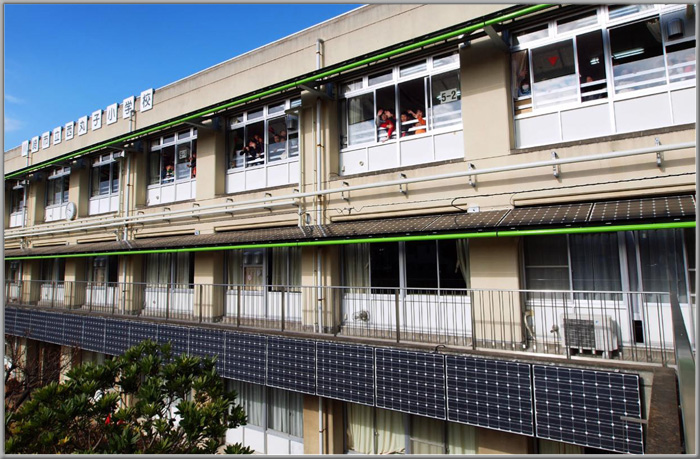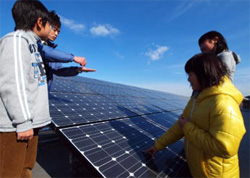Home > Highlighting JAPAN > Highlighting Japan FEBRUARY 2011 > Sustainable Cities
Highlighting JAPAN
COVER STORY: Sustainable Cities
Caption: Solar panels line a wall and the eaves of the Kawasaki City Nishimaruko Elementary School.
Credit: TADASHI AIZAWA
Sustainable Cities—Rethinking Japan's Community Spaces

Pupils at Nishimaruko Elementary examine the solar panels on the roof of their school.
Credit: TADASHI AIZAWA
Surrounded by the Tamagawa river, which forms the boundary between the Tokyo Metropolitan area and Kanagawa Prefecture and by Todoroki Green Park, the school is ideally suited to installation of solar panels in terms of solar irradiation conditions. "In winter, solar irradiation is poorer than in summer, but the output has so far reached a maximum of 80 kilowatts," says school principal Masahiro Watanabe.
As the solar power generation meets the power demands of the school, it ultimately cuts carbon dioxide emissions by up to 35 metric tons per year. This is roughly equivalent to planting ninety trees with a height of 10 meters.
In the new Environmental Study Room, a high-performance power storage system with lithium ion batteries has been installed. The system was developed by Eliiy Power Co., a business venture set up by professors of Keio University, when Kawasaki City invited them to take part in waterfront areas. The system stores electricity generated by solar panels. Given that the school is designated as an evacuation center in the event of disaster, the system is expected to serve as an emergency power source.
The solar panels also help with learning.
Sae Ogasawara, a fifth grader, says, "Now I feel that I understand environmental problems better than I did before, I study them with greater interest."
This issue's cover story focuses on activities in different parts of the country which seek to change the nature of cities in consideration of the environment while continuing to improve people's lives and maintaining industrial development.
© 2009 Cabinet Office, Government of Japan






